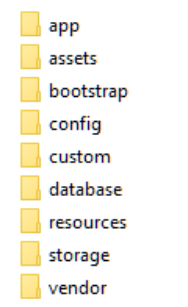Some Background
FusionInvoice was developed using the Laravel framework for PHP, and as such follows the MVC design pattern. If you have worked with Laravel, making modifications should be fairly straight forward. If not, the next two sections will cover a few topics that will help.
MVC- Model, View, Controller
Blades
Laravel uses a templating engine called Blades. A template in this case is simply a PHP file that allows you to use logic and control structures, like conditional statements and looping, to generate HTML output. Since blades are solely focused on UI/output, they are only used in views (never models or controllers).

*FI is written with the English language, but provides translations for Spanish, French, French-Canadian, Swedish, Dutch, Italian, German and Turkish. If you do not see your language listed, reach out and we can discuss adding it
Save Yourself Some Time and Effort
Stop! Before you jump right in and modify your database and/or change your core logic files, take a few minutes to look over the helpful tools and shortcuts that what we have provided to make your life easier.
Custom Views
Whenever possible, try to avoid modifying core logic files. Why? Because whenever we release an update, core files will be overwritten and you will need to re-make your original changes. The ./Custom/ folder is your friend. It provides a way for you to plug in your own views that will override the default ones.
For instance, say that you wanted to change the display order of a number of fields in the client display and edit views. To save yourself from the update overwrite headache mentioned above, you would navigate to the ./custom/overrides/ folder and create a new folder called “clients”. You would then copy the original _form.blade.php and view.blade.php files from ./app/modules/Clients/Views/Clients/ folder into your new ./custom/overrides/Clients/ folder. Any files in this folder by the same name as the core files will be used at runtime in place of the original files, and these custom/overrides files will not be overwritten by updates.
View Naming Conventions
Generally there are three types of blade views in FI.
Custom Invoice, Quote or Email Templates
Within the ./Custom/ folder, you will also notice folders for templates - email, invoice, and quotes. If you need to make a customization to the layout of any of these documents, make it here. It will avoid the potential for update overwrites and allows you to select from the original or custom versions when creating the documents.
Adding New Fields
FI has a very powerful Custom Fields system that you can use to quickly add custom fields to nearly any module, all without a single line of custom code.
You can add as many custom fields as you like to any of the following base tables: Clients, Company Profiles, Expenses, Invoices, Quotes, Recurring Invoices, Payments or Users. From the System menu - just select Custom Fields. You can choose from any of the following field types: Text, dropdown, text area, checkbox, radio, date, integer, URL, Email, Phone, Tag Selection, DateTime, Currency, Decimal, and Image.
Any custom fields that you add will automatically be displayed below the core fields in your module view.
Referencing Custom Fields in Invoice, Quote or Email Templates
You can also reference any of these new fields in your templates using the custom field label name, like this:
{{ $invoice->customField('Expected Delivery') }}
You can even reference a related custom field from the invoice to the related client entry like this:
{{ $invoice->client->customField('Favorite Color') }}
Need Deeper Integration In Your Views?
Do you want a custom field to be displayed amongst your core fields? You can do that, with just a little bit of additional code. For this example, we will use the Client module. We will integrate a custom field we created earlier, called “Customer Rating”, which is a dropdown field type. We will make it available on the display, edit, and index views. You can find the source blade files for these views in the ./app/Modules/Clients/Views/clients/ folder.
Remember, we do not want to modify core files, so we will copy these three files and place the copies in the view overrides folder for Clients, ./custom/overrides/clients/ . The files we will copy in this instance are: view.blade.php, _form.blade.php and index.blade.php. After making the copies, we are ready to modify our override files.
Adding a custom field to the Client DISPLAY view.
After finding the location where you would like the custom field to be placed, somewhere in the
<section class="content"> area,
you would add an entry referencing your custom field something like this:
<tr>
<td class="col-md-2 view-field-label">
Customer Rating
</td>
<td class="col-md-10">
{!! $client->customField('Customer Rating') !!}
</td>
</tr>
*Note that you must enter the custom field label name exactly as you created it, including the correct capitalization.
In this example we will use the Laravel blade syntax to conditionally color the background of the custom field if the customer “Customer Rating” value is “A1”.
@if ($client->customField('Customer Rating') == "A1")
<tr style="background-color: red;">
@else
<tr>
@endif
<td class="col-md-4">{!! $client->customField('Customer Rating') !!}</td>
</tr>
Adding a custom field to the Client EDIT view.
The syntax when referencing a custom field in an edit view is a little different, but also uses the custom field label as the point of reference. Example below:
<div class="col-md-4">
<div class="form-group">
@include('custom_fields._custom_fields_unbound', ['object' => isset($client) ? $client : [],'label' => 'Customer Rating'])
</div>
</div>
Adding a custom field to the Client INDEX (list) view.
In this example we will add our custom field for “Customer Rating” to the customer list (index.blade) file. We will also make it sortable by clicking on the column header.
In the index.blade.php <thread> section.
<th> {!! Sortable::link('Customer Rating', 'Customer Rating') !!} </th>
In the index.blade.php <tbody> section.
<td> class="hidden-xs">{{ $invoice->customField('Customer Rating') }} </td>
*Fields having multiple value options (like tags) are not sortable and are not suitable for displaying in list displays.